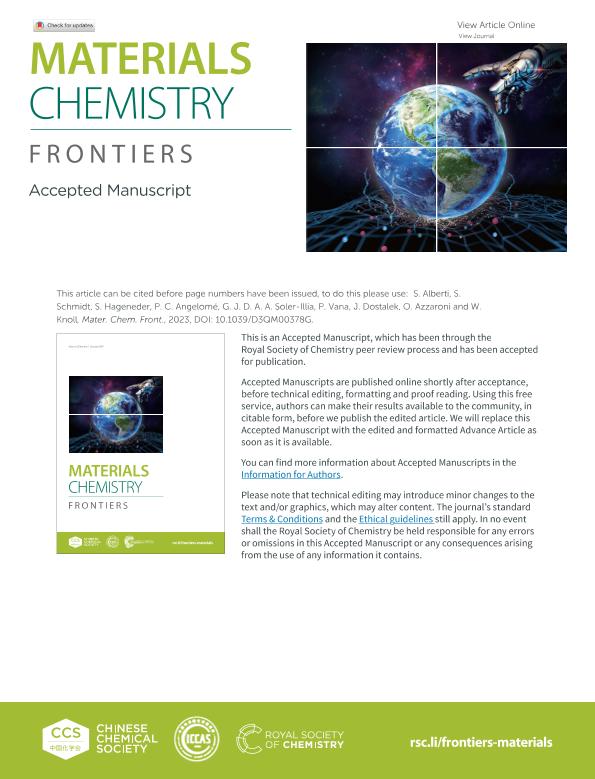Mostrar el registro sencillo del ítem
dc.contributor.author
Alberti, Sebastián

dc.contributor.author
Schmidt, Sonja
dc.contributor.author
Hageneder, Simone
dc.contributor.author
Angelome, Paula Cecilia

dc.contributor.author
Soler Illia, Galo Juan de Avila Arturo

dc.contributor.author
Vana, Philipp
dc.contributor.author
Dostalek, Jakub
dc.contributor.author
Azzaroni, Omar

dc.contributor.author
Knoll, Wolfgang
dc.date.available
2024-02-27T12:25:14Z
dc.date.issued
2023-07
dc.identifier.citation
Alberti, Sebastián; Schmidt, Sonja; Hageneder, Simone; Angelome, Paula Cecilia; Soler Illia, Galo Juan de Avila Arturo; et al.; Large-pore mesoporous silica: template design, thin film preparation and biomolecules infiltration; Royal Society of Chemistry; Materials Chemistry Frontiers; 7; 18; 7-2023; 4142-4151
dc.identifier.issn
2052-1537
dc.identifier.uri
http://hdl.handle.net/11336/228546
dc.description.abstract
Nanopores have been applied in the development of artificial biocatalytic systems, controlled drug delivery, and solid-state sensing devices. The interaction of biomacromolecules with surfaces show a dependence on the nanopore diameter, crucial in their ability to infiltrate porous materials. In this context, ordered mesoporous materials obtained by evaporation-induced self-assembly are model materials to test pore-biomolecule interactions. Nevertheless, these materials are generally restricted to pore diameters within the 2-10 nm range, therefore, new polymers as templating agents hold potential to provide an easy reproducible route for the synthesis of mesoporous silica thin films (MTF) with pore diameters above 10 nm without the use of swelling or additional structuring agents. Here, we present a novel and simple approach towards large pore MTF through the combination of supramolecular templating and phase separation with tailor-made block co-polymers. Accurate tuning of the oxide pore size distribution (with small mesopores between 13-18 nm diameter) is achieved by controlling the length and the nature of the hydrophilic polymer block used as a template through a simple reversible addition-fragmentation chain transfer (RAFT) polymerization approach. The importance of these features is highlighted by showing the capability that these new materials offer for biomolecule infiltration benchmarked against the widespread MTF prepared using pluronic F127 as a template. Effect of protein to pore diameter ratio, protein location and effect of pH and ionic strength is briefly tested and discussed.
dc.format
application/pdf
dc.language.iso
eng
dc.publisher
Royal Society of Chemistry

dc.rights
info:eu-repo/semantics/openAccess
dc.rights.uri
https://creativecommons.org/licenses/by/2.5/ar/
dc.subject
RAFT POLYMERIZATION
dc.subject
POROUS MATERIALS
dc.subject
THIN FILMS
dc.subject
PROTEIN INFILTRATION
dc.subject.classification
Nano-materiales

dc.subject.classification
Nanotecnología

dc.subject.classification
INGENIERÍAS Y TECNOLOGÍAS

dc.title
Large-pore mesoporous silica: template design, thin film preparation and biomolecules infiltration
dc.type
info:eu-repo/semantics/article
dc.type
info:ar-repo/semantics/artículo
dc.type
info:eu-repo/semantics/publishedVersion
dc.date.updated
2024-02-26T16:00:38Z
dc.journal.volume
7
dc.journal.number
18
dc.journal.pagination
4142-4151
dc.journal.pais
Reino Unido

dc.description.fil
Fil: Alberti, Sebastián. Consejo Nacional de Investigaciones Científicas y Técnicas. Centro Científico Tecnológico Conicet - La Plata. Instituto de Investigaciones Fisicoquímicas Teóricas y Aplicadas. Universidad Nacional de La Plata. Facultad de Ciencias Exactas. Instituto de Investigaciones Fisicoquímicas Teóricas y Aplicadas; Argentina
dc.description.fil
Fil: Schmidt, Sonja. Universität Göttingen; Alemania
dc.description.fil
Fil: Hageneder, Simone. Austrian Institute Of Technology; Austria
dc.description.fil
Fil: Angelome, Paula Cecilia. Consejo Nacional de Investigaciones Científicas y Técnicas. Oficina de Coordinación Administrativa Ciudad Universitaria. Unidad Ejecutora Instituto de Nanociencia y Nanotecnología. Unidad Ejecutora Instituto de Nanociencia y Nanotecnología - Nodo Constituyentes | Comisión Nacional de Energía Atómica. Unidad Ejecutora Instituto de Nanociencia y Nanotecnología. Unidad Ejecutora Instituto de Nanociencia y Nanotecnología - Nodo Constituyentes; Argentina
dc.description.fil
Fil: Soler Illia, Galo Juan de Avila Arturo. Universidad Nacional de San Martin. Instituto de Nanosistemas; Argentina. Consejo Nacional de Investigaciones Científicas y Técnicas; Argentina
dc.description.fil
Fil: Vana, Philipp. Universität Göttingen; Alemania
dc.description.fil
Fil: Dostalek, Jakub. Austrian Institute Of Technology; Austria
dc.description.fil
Fil: Azzaroni, Omar. Consejo Nacional de Investigaciones Científicas y Técnicas. Centro Científico Tecnológico Conicet - La Plata. Instituto de Investigaciones Fisicoquímicas Teóricas y Aplicadas. Universidad Nacional de La Plata. Facultad de Ciencias Exactas. Instituto de Investigaciones Fisicoquímicas Teóricas y Aplicadas; Argentina
dc.description.fil
Fil: Knoll, Wolfgang. Austrian Institute Of Technology; Austria
dc.journal.title
Materials Chemistry Frontiers
dc.relation.alternativeid
info:eu-repo/semantics/altIdentifier/url/http://pubs.rsc.org/en/Content/ArticleLanding/2023/QM/D3QM00378G
dc.relation.alternativeid
info:eu-repo/semantics/altIdentifier/doi/http://dx.doi.org/10.1039/D3QM00378G
Archivos asociados
